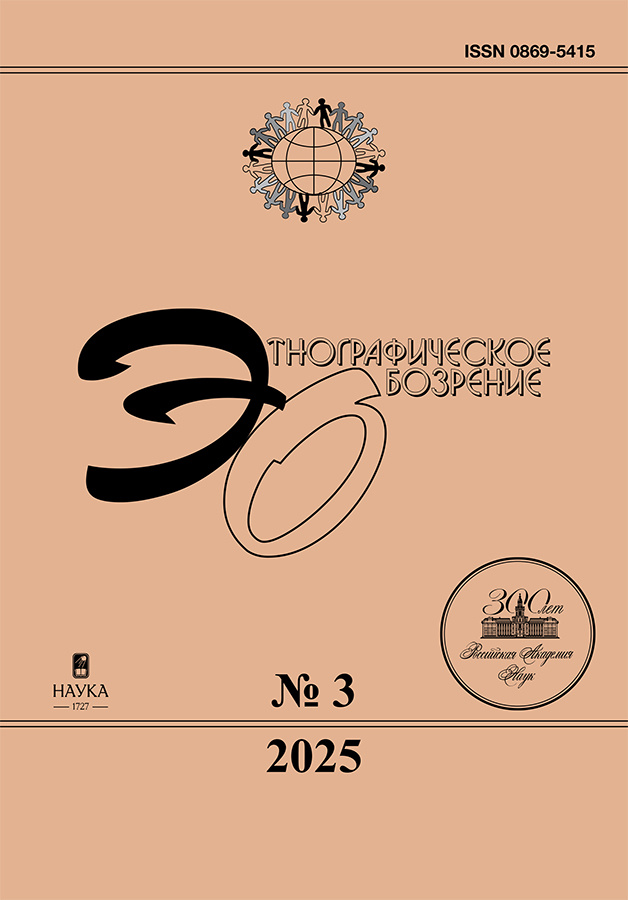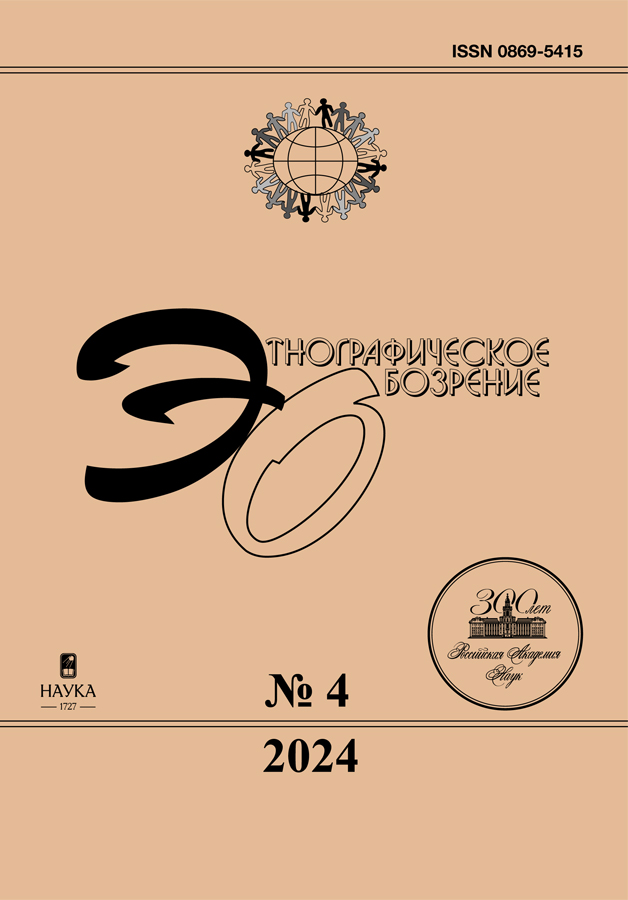Religious Inflection in the Economy of Experience: The Concept of Atmosphere in Aesthetic and Phenomenological Thought of Hermann Schmitz and Gernot Böhme
- Authors: Runkel S.1
-
Affiliations:
- Friedrich-Schiller-Universität Jena
- Issue: No 4 (2024)
- Pages: 56-69
- Section: Special Theme of the Issue: Anthropology of Affective Atmospheres
- URL: https://cijournal.ru/0869-5415/article/view/672450
- DOI: https://doi.org/10.31857/S0869541524040047
- EDN: https://elibrary.ru/AZAETX
- ID: 672450
Cite item
Abstract
The article offers a brief genealogy of the concept of atmosphere in the thought of Hermann Schmitz (New Phenomenology) and Gernot Böhme (Aesthetic Theory) to show that the concept takes on a quasi-religious appearance, especially in its design and economic applications. It is shown how a phenomenological concept of religious origin could become a pseudo-psychological marketing strategy. The article argues that the concept of atmosphere should not be applied too exclusively to the design of (interior) spaces, but that the sociality of atmospheres should also be taken into account. In this way, attention can be drawn to the manipulative power of the atmospheric.
Full Text
About the authors
Simon Runkel
Friedrich-Schiller-Universität Jena
Author for correspondence.
Email: simon.runkel@uni-jena.de
ORCID iD: 0000-0002-3774-2433
Institut für Geographie
Germany, Löbdergraben 32, 07743 JenaReferences
- Ahmed, S. 2010. Killing Joy: Feminism and the History of Happiness. Signs 35 (3): 571–594.
- Anderson, B. 2009. Affective Atmospheres. Emotion, Space and Society 2 (2): 77–81.
- Amphoux, P., J.-P. Thibaud, and G. Chelkoff. 2004. Ambiances en débats [Atmospheres in Debates]. Grenoble: A La Croiseé.
- Benjamin, W. 1991. Das Kunstwerk im Zeitalter seiner technischen Reproduzierbarkeit [The Work of Art in the Age of Its Technical Reproducibility]. In Gesammelte Schriften [Collected Works], by W. Benjamin. Vol. I, 2. Frankfurt am Main: Suhrkamp.
- Biehl-Missal, B., and M. Saren. 2012. Atmospheres of Seduction: A Critique of Aesthetic Marketing Practices. Journal of Macromarketing 32 (2): 168–180.
- Binswanger, L. 1933. Das Raumproblem in der Psychopathologie [The Space Problem in Psychopathology]. Zeitschrift für die gesamte Neurologie und Psychiatrie 145 (1): 598–647.
- Bollnow, O.F. 2010. Mensch und Raum [Man and Space]. Stuttgart: Kohlhammer.
- Böhme, G. 2010. Das Leistungsprinzip und das Reich der Freiheit [The Performance Principle and the Realm of Freedom]. In Kritik der Leistungsgesellschaft [Criticism of Meritocracy], edited by G. Böhme, 13–22. Basel: Aisthesis-Verlag.
- Böhme, G. 2013. Atmosphäre. Essays zur neuen Ästhetik [The Atmosphere: Essays on the New Aesthetics]. Berlin: Suhrkamp.
- Brennan, T. 2004. The Transmission of Affect. Ithaca: Cornell University Press.
- Clough, P.T., and J. Halley, eds. 2007. The Affective Turn: Theorizing the Social. Durham: Duke University Press.
- Düttmann, S. 2000. Ästhetische Lernprozesse. Annäherungen an atmosphärische Wahrnehmungen von LernRäumen [Aesthetic Learning Processes: Approaches to Atmospheric Perceptions of Learning Spaces]. Marburg: Tectum Verlag.
- Eliade, M. 1998. Das Heilige und das Profane. Vom Wesen des Religiösen [The Sacred and the Profane: On the Nature of Religion]. Frankfurt am Main: Insel.
- Fisher, L., and L. Embree, eds. 2000. Feminist Phenomenology. Dordrecht: Springer.
- Gieseke, W. 2010. Atmosphäre in Bildungskontexten – Beziehungstheoretische Überlegungen [Atmosphere in Educational Contexts – Considerations on Relationship Theory]. In Sinnliche Bildung? Pädagogische Prozesse zwischen vorprädikativer Situierung und reflexivem Anspruch [Sensual Education? Pedagogical Processes between Predicative Situation and Reflective Demands], edited by R. Egger and B. Hackl, 57–70. Wiesbaden: VS Verlag für Sozialwissenschaften.
- Gregg, M., and G.J. Seigworth, eds. 2010. The Affect Theory Reader. Durham: Duke University Press.
- Griffero, T. 2014. Atmospheres: Aesthetics of Emotional Spaces. Aldershot: Ashgate.
- Griffero, T. 2020. Places, Affordances, Atmospheres: A Pathic Aesthetics. London: Routledge.
- Griffero, T. 2021. The Atmospheric “We”: Moods and Collective Feelings. Milan: Mimesis International.
- Hasse, J. 2002. Zum Verhältnis von Stadt und Atmosphäre. Wo sind die Räume der Urbanität? [On the Relationship between City and Atmosphere: Where are the Spaces of Urbanity?]. In Subjektivität in der Stadtforschung [Subjectivity in Urban Research], edited by J. Hasse, 19–41. Frankfurt am Main: Institut für Didaktik der Geographie.
- Hasse, J. 2004. Kaufhausatmosphären [Shopping Atmospheres]. Der Architekt 5–6: 39–42.
- Hasse, J. 2005. Fundsachen der Sinne: eine phänomenologische Revision alltäglichen Erlebens [The Lost and Found of the Senses: A Phenomenological Revision of Everyday Experience]. München: Karl Alber.
- Hasse, J. 2009. Räume der Pädagogik – zwischen Funktion und Subversion [Spaces of Pedagogy – between Function and Subversion]. Pädagogische Rundschau 63 (3): 369–385.
- Hasse, J. 2012. Atmosphären der Stadt: Aufgespürte Räume [Atmospheres of the City: Discovered Spaces]. Berlin: Jovis.
- Hasse, J. 2014. Was Räume mit uns machen – und wir mit ihnen. Kritische Phänomenologie des Raumes [What Spaces Do to Us – And We to Them: Critical Phenomenology of Space]. München: Verlag Karl Alber.
- Haug, F. 1971. Kritik der Warenästhetik [Criticism of Commodity Aesthetics]. Frankfurt am Main: Suhrkamp.
- Hauskeller, M. 1995. Atmosphären erleben. Philosophische Untersuchungen zur Sinneswahrnehmung [Experience Atmospheres: Philosophical Investigations into Sensory Perception]. Berlin: Akademischer Verlag.
- Heidegger, M. 2006. Sein und Zeit [Being and Time]. Tübingen: Niemeyer.
- Huber, F., M. Lenzen, S. Vizethum, and I. Weißhaar. 2013. Erlebnis-Shopping Concept Stores. Eine empirische Analyse des Einkaufserlebnisses durch Lifestyle und Atmosphäre [Experience Shopping Concept Stores: An Empirical Analysis of the Shopping Experience through Lifestyle and Atmosphere]. Lohmar: Josef Eul Verlag.
- Kazig, R. 2007. Einkaufsatmosphären: Ein wichtiges Kriterium für die Einkaufsstättenwahl [Shopping Atmosphere: An Important Criterion for Choosing a Shopping Location]. CIMA direkt (1): 23–25.
- Kazig, R. 2007. Atmosphären – Konzept für einen nicht repräsentationellen Zugang zum Raum [Atmospheres – Concept for a Non-Representational Approach to Space]. In Kulturelle Geographien. Zur Beschäftigung mit Raum und Ort nach dem Cultural Turn [Cultural Geographies: On Dealing with Space and Place after the Cultural Turn], edited by C. Berndt and R. Pütz, 167–187. Bielefeld: Transcript.
- Laketa, S., and S. Fregonese. 2022. Urban Atmospheres of Terror. Political Geography 96: 102569.
- Leichtle, V.A. 2009. Handbuch für atmosphärische Gestaltung im Hotel: Ambiente schaffen – Sinne berühren – Gäste begeistern [Handbook for Atmospheric Design in Hotels: Create Ambience – Touch the Senses – Inspire Guests]. Berlin: Erich Schmidt Verlag.
- Lévi-Strauss, C. 1987. Introduction to the Work of Marcel Mauss. London: Routledge & Kegan Paul.
- Lipczinsky, M., and H. Boerner. 2001. Shop-Design für erfolgreiche Läden: Atmosphäre schaffen mit Raumpsychologie und Feng Shui [Shop Design for Successful Stores: Creating Atmosphere with Spatial Psychology and Feng Shui]. München: Callwey.
- Mills, S. 1996. Gender and Colonial Space. Gender, Place & Culture 3 (2): 125–148.
- Müller, J. 2012. Multisensuale Gestaltung der Ladenatmosphäre zur Profilierung von Store Brands. Ein theoriegeleitetes, experimentelles Design zum Shopperverhalten [Multi-Sensual Design of the Store Atmosphere to Profile Store Brands: A Theory-Driven, Experimental Design for Shopping]. Wiesbaden: Springer Gabler.
- Nohl, A.-M., and C. Wulf. 2013. Die Materialität pädagogischer Prozesse zwischen Mensch und Ding [The Materiality of Pedagogical Processes Between People and Things]. Zeitschrift für Erziehungswissenschaft 16 (2): 1–13.
- Otto, R. 2013. Das Heilige: Uber das Irrationale in der Idee des Göttlichen und sein Verhältnis zum Rationalen [The Sacred: About the Irrational in the Idea of the Divine and Its Relationship to the Rational]. München: C.H. Beck.
- Pallasmaa, J. 2014. Space, Place and Atmosphere: Emotion and Peripherical Perception in Architectural Experience. Lebenswelt – Aesthetics and Philosophy of Experience 4: 230–245.
- Pine II, B.J., and J.H. Gilmore. 2011. The Experience Economy. Boston: Harvard Business Review Press.
- Rauh, A. 2012. Die besondere Atmosphäre: Ästhetische Feldforschungen [The Special Atmosphere: Aesthetic Field Research]. Bielefeld: Transcript.
- Riedel, F. 2015. Music as Atmosphere: Lines of Becoming in Congregational Worship. Lebenswelt – Aesthetics and Philosophy of Experience 6: 80–111.
- Riedel, F. 2020. Affect and Atmosphere – Two Sides of the Same Coin? In Music as Atmosphere: Collective Feelings and Affective Sounds, edited by F. Riedel and J. Torvinen, 262–273. Abingdon: Routledge.
- Riedel, F., and J. Torvinen, eds. 2020. Music as Atmosphere: Collective Feelings and Affective Sounds. Abingdon: Routledge.
- Rodatz, C. 2010. Der Schnitt durch den Raum. Atmosphärische Wahrnehmung in und außerhalb von Theaterräumen [The Cut Through Space: Atmospheric Perception in and Outside Theater Spaces]. Bielefeld: Transcript.
- Rose, G. 1993. Feminism and Geography: The Limits of Geographical Knowledge. London: Polity Press.
- Runkel, S. 2016. Zur Genealogie des Atmosphären-Begriffs. Eine kritische Würdigung der Ansätze von Hermann Schmitz und Gernot Böhme [On the Genealogy of the Concept of Atmosphere: A Critical Assessment of the Approaches of Hermann Schmitz and Gernot Böhme]. In Atmosphären des Populären II. Perspektiven, Projekte, Protokolle, Performances, Personen, Posen [Atmospheres of the Popular II: Perspectives, Projects, Protocols, Performances, People, Poses], edited by U. Wünsch, 20–39. Berlin: Uni-Edition.
- Runkel, S. 2018. Collective Atmospheres: Phenomenological Explorations of Protesting Crowds with Canetti, Schmitz, and Tarde. Ambiances – International Journal of Sensory Environment, Architecture and Urban Space. March 2018. http://journals.openedition.org/ ambiances/1067
- Schmitz, H. 1998. Situationen und Atmosphären: Zur Ästhetik und Ontologie bei Gernot Böhme [Situations and Atmospheres: On Aesthetics and Ontology in Gernot Böhme]. In Naturerkenntnis und Natursein [Knowledge of Nature and Being Nature], edited by G. Böhme, M. Hauskeller, C. Rehmann-Sutter, and G. Schiemann, 176–190. Frankfurt am Main: Suhrkamp.
- Schmitz, H. 2005. Der Gefühlsraum. System der Philosophie [The Emotional Space: System of Philosophy]. Vol. 3 (2), Der Raum [Space]. Bonn: Bouvier Verlag.
- Schmitz, H. 2009. Der Leib, der Raum und die Gefühle [The Body, the Space and the Feelings]. Bielefeld: Aisthesis Verlag.
- Schmitz, H. 2014. Atmosphären [Atmospheres]. München: Verlag Karl Alber.
- Schmitz, H. 2020. Intensity, Atmospheres and Music. In Music as Atmosphere: Collective Feelings and Affective Sounds, edited by F. Riedel and J. Torvinen, 60–69. Abingdon: Routledge.
- Schmitz, H., R.O. Müllan, and J. Slaby. 2011. Emotions Outside the Box – The New Phenomenology of Feeling and Corporeality. Phenomenological Cognitive Sciences 10 (2): 241–259.
- Schouten, S. 2007. Sinnliches Spüren: Wahrnehmung und Erzeugung von Atmosphären im Theater [Sensual Sensing/Marks: Perception and Creation of Atmospheres in the Theatre]. Berlin: Theater der Zeit.
- Schulze, G. 1992. Die Erlebnisgesellschaft. Kultursoziologie der Gegenwart [The Adventure Society. Contemporary Cultural Sociology]. Frankfurt am Mane: Campus.
- Seyfert, R. 2011. Atmosphären – Transmissionen – Interaktionen: Zu einer Theorie sozialer Affekte [Atmospheres – Transmissions – Interactions: Towards a Theory of Social Affects]. Soziale Systeme 17 (1): 73–96.
- Slaby, J. 2020. Atmospheres – Schmitz, Massumi and Beyond. In Music as Atmosphere: Collective Feelings and Affective Sounds, edited by F. Riedel, and J. Torvinen, 274–285. Abingdon: Routledge.
- Sloterdijk, P. 2004. Sphären III – Schäume. Plurale Sphärologie [Spheres III – Foams: Plural Spherology]. Frankfurt am Main: Suhrkamp.
- Stewart, K. 2011. Atmospheric Attunements. Environment and Planning D: Society and Space 29 (3): 445–453.
- Taylor, C. 2012. Ein säkulares Zeitalter [A Secular Age]. Frankfurt am Main: Suhrkamp.
- Tellenbach, H. 1968. Geschmack und Atmosphäre. Medien menschlichen Elementarkontakts [Taste and Atmosphere: Media of Human Elemental Contact]. Salzburg: O. Müller.
- Thibaud, J.-P., and C.R. Duarte. 2013. Ambiances urbaines en partage [Shared Urban Atmospheres]. Genève: MetisPresses.
- Uhrich, S. 2008. Stadionatmosphäre als verhaltenswissenschaftliches Konstrukt im Sportmarketing. Entwicklung und Validierung eines Messmodells [Stadium Atmosphere as a Behavioral Scientific Construct in Sports Marketing: Development and Validation of a Measurement Model]. Wiesbaden: Gabler; GWV Fachverlage.
- van der Leeuw, G. 1970. Phänomenologie der Religion [Phenomenology of Religion]. Tübingen: Mohr Siebeck.
- Wünsch, U. 2012. Event als Interaktion und Inszenierung: Ein Beitrag zu Theorie und Praxis der Medienästhetik [Event as Interaction and Staging: A Contribution to the Theory and Practice of Media Aesthetics]. Berlin: Uni-Edition.
- Zumthor, P. 2006. Atmospheres – Architectural Environments – Surrounding Objects. Basel: Birkhäuser.
Supplementary files











